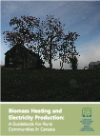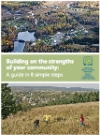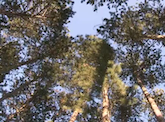Creating a Circle of Wealth in Clayoquot
With the recently held Crown-First Nation Gathering in Ottawa, and the situation in Attawapiskat still desperate, it's an apt time to showcase the possibilities and opportunities that exist when First Nations’ traditional values and knowledge are incorporated in addressing issues such as poor housing to come up with a new approach.
In Clayoquot Sound, Ecotrust Canada and the Clayoquot Forest Communities Program are working with Nuu-chah-nulth communities to do just that – as was recently reported on by Duncan McCue on CBC’s The National. To watch the January 24, 2012 report regarding this work, which aims to improve the 'circle of wealth' by linking housing, employment, capacity building and economic development, please click here: CBC News . For more on this project, please see our Feature Project article below.
Feature Project: CFC Addresses First Nations Housing Crisis
Found in the Clayoquot Forest Communities: green and culturally appropriate building design
With the recent spotlight on the Attawapiskat First Nation, the ongoing crisis in First Nations housing around the country is finally being given the attention it deserves. There has never been a better time to share the work being done by, and with, the Nuu-chah-nulth First Nations in Clayoquot Sound to solve their housing issues.
Recognizing that working together is the only way forward, and that solutions will come from First Nations communities, the Clayoquot Forest Communities and Ecotrust Canada are working with Nuu-chah-nulth communities in Clayoquot Sound (and other partners) to design and create green and culturally appropriate homes and community buildings. The goal is to create a housing style that meets the needs of wet, west coast living, and which factors in the economy and ecosystems of Clayoquot Sound.
The project also aims to:
- Recognize both present circumstances and future prospects;
- Embrace the wisdom to be found in traditional values and use traditional knowledge as a sound starting ground;
- Use local resources and local labour, thus building local capacity;
- Grow and restore community skills.
To this end, the design of the homes will take into account cultural design elements such as the traditional long house design; use of locally harvested and milled materials such as cedar; local geography; climate; and community demographics.
Why the need?
To combat overcrowding issues, it has been estimated that there is a need for over 350 affordable, durable homes to be built in Clayoquot’s First Nation communities over the next 10 years. Coupled with this is a desire to change how current homes are designed and built in an effort to overcome issues caused by weather, projected climate changes and recent use of poor quality, non-local materials.
EOMF Releases First YouTube Forest Certification Video
The Eastern Ontario Model Forest has just released the first in its new Forest Certification video series. Chain of Custody Certification provides a visually appealing and understandable overview of this often complex subject matter. Stay tuned for three more videos in this Forest Certification series to be released in the next couple of months featuring: private land certification; community forest certification; and maple syrup certification. Please click the link below that leads to EOMF's new YouTube EOMF channel and Chain of Custody Certification video: http://www.youtube.com/watch?v=mw1d48JVpdo
Swedish Minister and Entourage Visit CMFN in Limerick Forest
In response to a request by the International Model Forest Network Secretariat (IMFN), based in Ottawa, the Canadian Model Forest Network (CMFN) and the Eastern Ontario Model Forest (EOMF) were pleased to co-host two separate international delegations for a day each - one from Sweden and one from Africa. In each instance, carefully chosen agenda’s and relevant venues were planned to transfer knowledge to the visitors on their chosen topics of interest. On the flipside, we also learned about their unique issues, challenges and initiatives.
The delegation from Sweden included the Swedish Minister for Rural Affairs, Mr. Eskil Erlandsson; Sweden's Ambassador to Canada, Mr. Teppo Tauriainen; the Director of the Swedish Forest Agency, Mr. Peter Blombeck; and their entourage. Leanne Elliott, General Manager of the CMFN, gave an informative overview of the Network and also outlined a new Tri-lateral Agreement between Canada, Sweden and Chile that set-out parameters for project collaboration. This Agreement was signed at CMFN’s 2011 Annual General Meeting in June.
The Swedes were also interested in learning about major landscape issues facing the EOMF as well as their Forest Certification Program and how they engage with First Nations. Sweden shares a similar settled landscape fabric to Eastern Ontario's so their challenge too is to engage and educate private woodlot owners on sustainable forest management practices to ensure the health and longevity of this vital resource. Sweden is also home to an indigenous group called the Sami - whose culture is traditionally based on reindeer herding amidst the mountains that wind through the northern and central areas of the country. Encompassing their traditional lands is the Vilhelmina Model Forest which helps to conserve and support their culture, and has developed sophisticated GIS-modelling tools to help the Suni's and other Swedes to better understand the factors impacting herding and the forest in general.
This day of focused meetings in an FSC-certified log chalet, was capped off my a great lunch and a guided tour of sustainable forest management practices performed by Geoff McVey, Forest Manager, and Rob Ross, Forest Technician, at Limerick Forest in the United Counties of Leeds-Grenville (UCLG). UCLG Warden Mel Campbell, and County Councillor Doug Struthers also welcomed the delegation, presented them with gifts, and participated in the day's session.
Publication en Vedette
Veuillez cliquez ici pour les nouvelles des membres
Établir des liens entre les partenaires
 Établi au Canada pour répondre à une demande, nationale et internationale, de pratiques de gestion durable de la forêt, le Réseau canadien de forêts modèles (RCFM) a été créé au début des années 1990.
Établi au Canada pour répondre à une demande, nationale et internationale, de pratiques de gestion durable de la forêt, le Réseau canadien de forêts modèles (RCFM) a été créé au début des années 1990.
Publications récentes
-
Production d'électricité et de chaleur à partir de la biomasse : Un guide pour les communautés rurales au canada

Le Canada est un pays riche en ressources qui soutient une foule d'industries de ressources renouvelables et non renouvelables. Les Canadiens sont les intendants d'une grande partie des forêts tempérées et boréales de la planète. Ces forêts offrent un éventail de services écologiques : de la purification et de l'entreposage de l'eau, la protection de la qualité de l'air, contre les inondations, l'érosion à la création d'habitats fauniques. Les forêts jouent également un rôle clé dans l'atténuation des changements climatiques. En effet, selon les estimations, les forêts canadiennes piègent 95 milliards de tonnes de carbone. Les forêts offrent un éventail de valeurs économiques : des produits conven- tionnels aux valeurs récréatives, au piégeage et au potentiel de production énergétique.
-
Mettre à profit les forces de votre communauté

Chaque forêt modèle fonctionne au niveau régional pour promouvoir la gestion durable des paysages forestiers importants grâce à la recherche, l'éducation et les projets appliqués. Forêts Modèles soutenir les collectivités forestières en rassemblant les informations, les outils et les meilleures pratiques nécessaires pour surmonter les obstacles et identifier de nouvelles opportunités. Ce guide a été élaboré dans le cadre du développement socio-économique du programme d'indicateurs. Il est soutenu par un comité de pilotage des membres du RCFM et des partenaires de partout au pays.
-
Voies vers la résilience au changement climatique
Le présent guide et la Collection de ressources pour les collectivités qui l’accompagne ont été conçus en partant du principe que les collectivités rurales canadiennes en milieu forestier désirent être orientées pour comprendre et passer à l’action afin de réduire les impacts du changement climatique. Le recueil d’information et d’outils existants en un cadre pratique a constitué la première étape de l’initiative.
For Resource Collection Click Here and for the Guidebook Click Here







